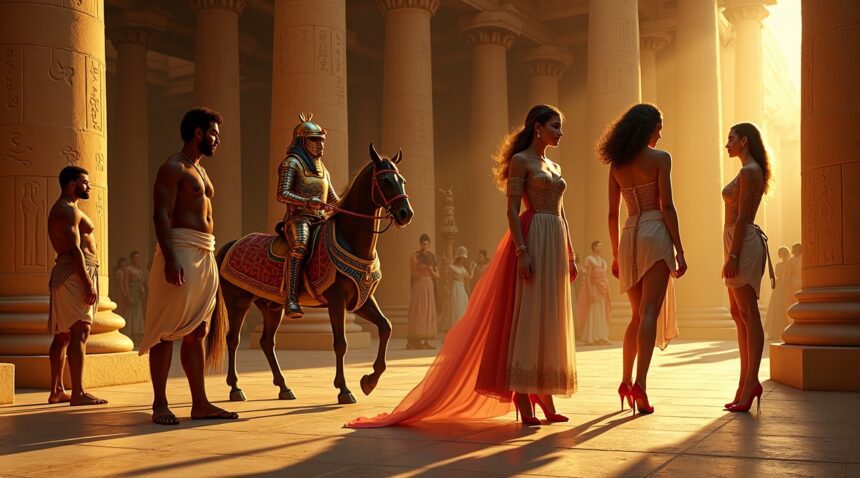High heels trace their origins back 5,500 years to ancient Egypt, where men wore them exclusively as powerful symbols of status, authority, and ceremonial importance.
Key Takeaways
- High heels originated in ancient Egypt around 3500 BCE as masculine footwear worn by butchers, priests, and nobility to demonstrate social hierarchy and authority.
- Persian horsemen and medieval knights used heeled boots for practical purposes, providing better stability and control while mounted on horseback during combat.
- European royalty, particularly Louis XIV of France, elevated high heels into symbols of power, with red 4-inch heels becoming exclusive to the upper classes.
- The Age of Enlightenment led to a decline in male high heel fashion as society shifted toward valuing rationality and practicality over decorative displays.
- The 20th century redefined high heels through celebrity influence, with icons like Marilyn Monroe and Audrey Hepburn establishing them as symbols of feminine glamour and empowerment.
From Ancient Egypt to Your Closet: The Surprising 5,500-Year Journey of High Heels
The history of high heels stretches back an astonishing 5,500 years to ancient Egypt around 3500 BCE, where elevated footwear served purposes far beyond fashion. Egyptian society recognized high heels as powerful symbols of status, authority, and ceremonial importance, establishing patterns that continue to influence modern footwear today.
Egyptian butchers pioneered one of the most practical applications of early high heels, crafting elevated soles from wood or cork to keep their feet above the blood-soaked floors of their workplaces. This functional approach demonstrates how ancient Egyptians ingeniously solved everyday problems while simultaneously creating a distinctive visual marker of their profession. The elevated design allowed these workers to maintain both hygiene and dignity in their demanding trade.
Status Symbols in Ancient Egyptian Society
Archaeological evidence reveals that high heels functioned as clear indicators of social hierarchy in ancient Egyptian culture. Elite members and royalty adorned their feet with gold sandals and ornately decorated footwear that proclaimed their elevated position in society. These luxurious pieces served dual purposes as both practical protection and unmistakable displays of wealth and power.
Ancient Egyptian art and tomb reliefs provide compelling visual documentation of this social stratification through footwear. Artists consistently portrayed nobility and high-ranking individuals wearing elaborate elevated shoes, while depicting commoners as barefoot. This artistic convention wasn’t mere aesthetic choice—it reflected genuine social realities where access to fine footwear directly correlated with one’s position in the social hierarchy.
The materials used in ancient Egyptian high heels carried profound symbolic significance that extended beyond mere decoration. Craftsmen selected wood, cork, leather, ivory, and precious metals based on their cultural meanings and the wearer’s intended message. Gold held particular importance, representing divine authority and eternal power. When combined with white materials, these sandals took on additional spiritual significance, denoting purity and sacred purpose.
White or gold sandals played essential roles in ritual and funerary rites, where their symbolic properties became as important as their practical function. Priests and participants in religious ceremonies wore these specially crafted shoes to demonstrate their connection to the divine and their authority to perform sacred duties. The elevated design literally raised the wearer above the common ground, reinforcing their spiritual and social elevation.
Egyptian tomb paintings often feature elaborate scenes where deceased nobles wear their finest high heels, suggesting these items held such importance that they accompanied their owners into the afterlife. This practice indicates that elevated footwear wasn’t simply about earthly status—it represented lasting authority that transcended death itself.
The craftsmanship involved in creating these ancient high heels required substantial skill and resources, making them accessible only to those with significant wealth. Artisans carved intricate designs into wooden soles, applied gold leaf with precision, and embedded precious stones in carefully planned patterns. Each pair represented hours of specialized labor, adding to their value as status symbols.
Modern fashion owes a considerable debt to these ancient Egyptian innovations. The fundamental concept of using elevated footwear to convey authority, enhance stature, and make social statements originated in Egyptian society and has persisted through millennia. Today’s high heels continue this tradition, though their primary associations have shifted from masculine authority to feminine fashion.
Understanding this historical context reveals how ancient Egyptian culture influenced contemporary fashion in ways most people never realize. The next time someone steps into a pair of high heels, they’re participating in a cultural practice that connects them directly to Egyptian pharaohs, priests, and skilled craftsmen who first recognized the power of elevated footwear to transform both appearance and social perception.

When Knights and Kings Ruled in Heels: Men’s Original Claim to Elevated Fashion
High heels began their journey as distinctly masculine footwear, serving both practical purposes and status symbols across ancient civilizations. I find it fascinating that long before women claimed heels as their fashion territory, men wore elevated shoes to demonstrate power, authority, and social standing.
The practical advantages of heeled footwear became particularly evident during the Middle Ages among knights and cavalry soldiers. Persian horsemen of the 9th–10th centuries CE developed heeled boots specifically to secure their feet in stirrups during combat and long rides. Knights adopted similar designs, recognizing that elevated heels provided better stability and control while mounted on horseback. This wasn’t merely about fashion – it was essential military equipment that could mean the difference between life and death in battle.
Classical civilizations embraced elevated footwear as powerful status indicators. Greek actors wore platform shoes called kothorni to elevate their stature both literally and figuratively on stage, with heel height often corresponding to character importance. Roman aristocrats understood this connection between height and authority, incorporating high heels into their daily wardrobes as visible symbols of their elevated social position. The ancient Greek influence on Roman culture extended to footwear choices that reinforced hierarchical structures.
Royal Fashion Statements That Defined Masculine Power
European royalty transformed high heels into ultimate symbols of masculine dominance and royal authority. French monarch Louis XIV elevated this trend to new heights, literally wearing 4-inch red heels that became his signature look. His choice wasn’t arbitrary – the towering heels emphasized his divine right to rule and physically elevated him above his subjects and courtiers. Red became the color of royal privilege, with laws restricting who could wear red heels based on social rank.
Charles II of England followed suit in 1661, adopting red heels as part of his royal fashion statement after his restoration to the throne. English nobility quickly embraced this trend, understanding that elevated footwear communicated wealth, power, and proximity to royal favor. Court etiquette often revolved around heel height and color, creating intricate social hierarchies based on footwear choices.
The practical benefits extended beyond horseback riding throughout medieval Europe. Elevated shoes helped men navigate muddy streets and unsanitary conditions common in urban centers. Wealthy merchants and nobles used heel height to literally rise above the filth of daily life while simultaneously displaying their economic status. Higher heels required more expensive materials and skilled craftsmanship, making them accessible only to those with substantial means.
Persian culture continued influencing European heel design through trade relationships and cultural exchange. Military leaders recognized that heeled boots provided tactical advantages during mounted warfare, leading to widespread adoption across various armies. The functionality of heels in stirrups became so valued that cavalry units standardized heel specifications for optimal performance.
Throughout these centuries, high heels remained firmly associated with masculine identity, power projection, and practical utility. Men wore heels to command respect, demonstrate authority, and gain literal height advantages in social situations. The transition from male to female fashion wouldn’t occur until much later, making the original masculine heritage of high heels a forgotten chapter in fashion history that challenges modern assumptions about gendered clothing.
From ancient Egyptian ceremonies to Persian cavalry units and European royal courts, men claimed high heels as symbols of strength, status, and sophistication long before they became associated with feminine fashion.

The Great Gender Flip: How High Heels Became a Woman’s World
I find it fascinating how dramatically footwear can transform its cultural meaning over centuries. The transition of high heels from male authority symbols to feminine fashion statements represents one of history’s most striking gender reversals in clothing.
The Enlightenment’s Impact on Male Fashion
The Age of Enlightenment in the 18th century fundamentally changed how men approached fashion. As society began emphasizing rationality and practicality above ornate displays, men gradually abandoned elaborate attire that had once signified their status. High heels, previously essential for demonstrating power and authority, suddenly appeared frivolous and impractical. This cultural shift created an opening that would eventually reshape the heel’s identity entirely.
Men’s retreat from decorative fashion didn’t happen overnight, but it was decisive. The emphasis on reason and functionality made elevated footwear seem contradictory to Enlightenment values. Consequently, heels began their migration from masculine wardrobes to feminine ones, though this transition took several generations to complete.
The Rise of Feminine Heel Culture
The stiletto heel’s introduction marked a pivotal moment in this transformation. This ultra-thin, towering heel became synonymous with elegance, allure, and a distinctly feminine form of power. Unlike the chunky heels that men had worn for practical purposes, stilettos served purely aesthetic functions while making bold statements about their wearers.
During the 20th century, high heels gained unprecedented cultural prominence through popular culture and cinema. Movie icons transformed heels into symbols of glamour and female empowerment. Marilyn Monroe’s sultry walk in heels became legendary, while Audrey Hepburn elevated them to sophisticated elegance. These cultural moments cemented heels’ association with femininity in the public consciousness.
Celebrity influence proved crucial in establishing heels as feminine fashion staples. Each iconic appearance reinforced the connection between elevated footwear and women’s style. The transformation was so complete that by the mid-20th century, few people remembered heels’ masculine origins.
Modern heels come in countless variations—pumps, sandals, boots, platforms—each serving different aesthetic and social purposes. Women wear them to make fashion statements, display status, or project authority in professional settings. The irony isn’t lost that heels have returned to their original function as authority symbols, just worn by a different gender.
Social norms, fashion evolution, and celebrity culture collectively reshaped what high heels represented. The journey from Egyptian men’s status symbols to modern women’s empowerment tools demonstrates how dramatically clothing meanings can shift across cultures and centuries. Fashion doesn’t just follow trends; it actively participates in defining gender roles and social expectations.
This gendered transformation reveals how arbitrary many fashion associations truly are. The same footwear that once proclaimed masculine authority now primarily serves feminine expression. The heel’s journey illustrates fashion’s power to reinvent itself while carrying forward echoes of its historical significance.

Sources:
Shoegummi – The History of High Heels
Ancient Origins – High Heels for Men?
Study.com – History of High Heels: Timeline, Invention & Origin
Mens Heels – Stepping Through Time in Style: The History of Men’s High Heels
Egypt Museum – Gold Sandals of Shoshenq II
Art of Counting – Analysis of Royal Sandals in Ancient Egypt, Part 1
Historical Eve – The Sandals of Ancient Egypt
Vicson – The History of High Heels


